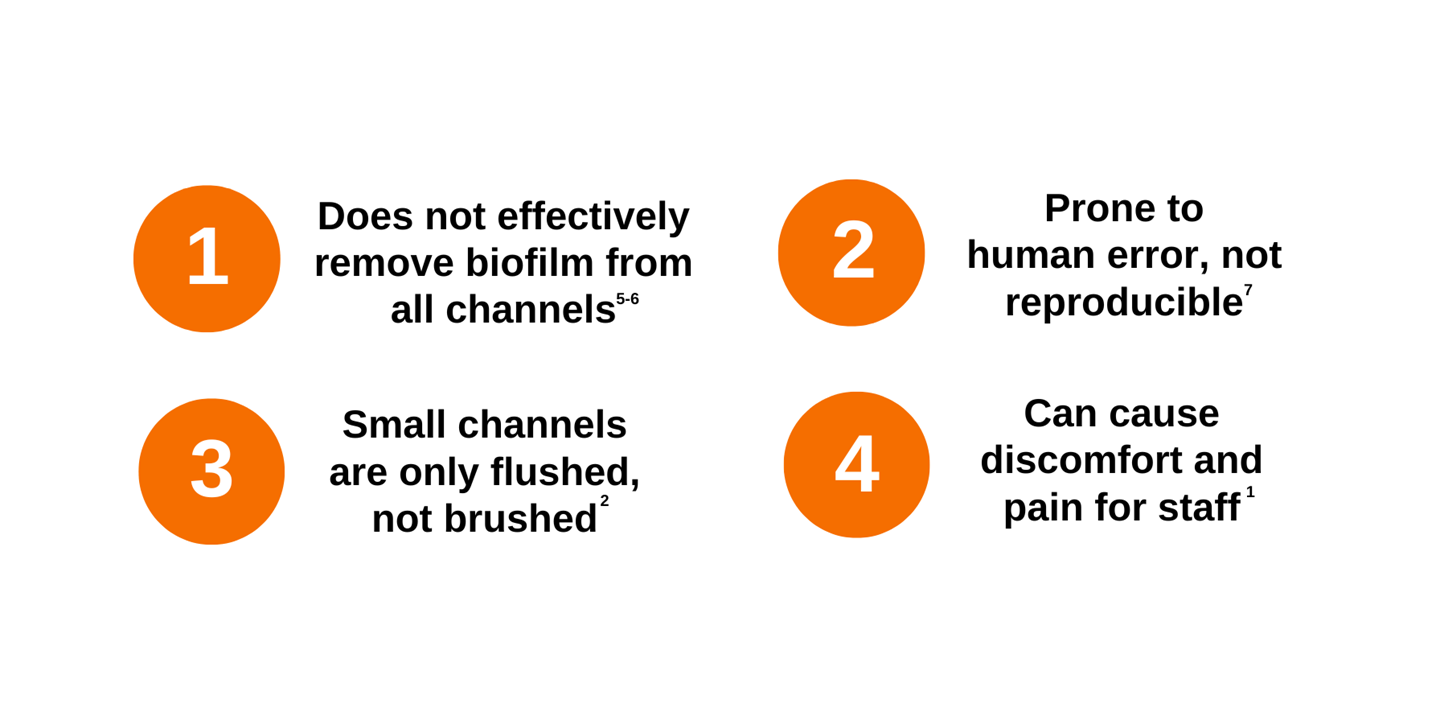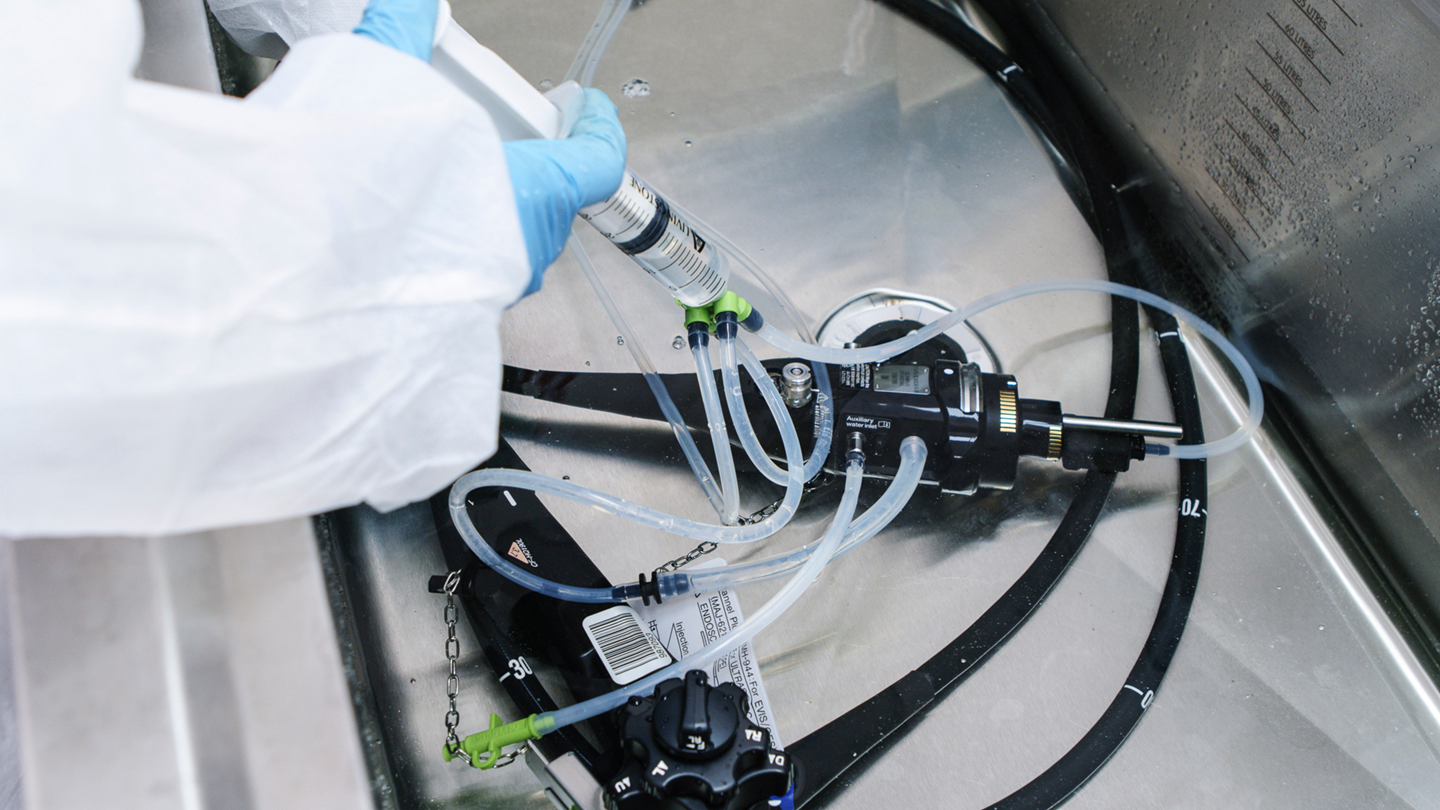Manual cleaning is the most challenging, but most critical, part of endoscope reprocessing.1,2 Even when performed with adherence to guidelines and IFUs, studies show that manual cleaning can fail to systematically remove soil from endoscopes.3,4
Key problems with manual endoscope cleaning

Manual cleaning does not effectively remove biofilm from all channels
It is essential that biofilm is removed during the manual cleaning phase, as it can survive high-level disinfection.8,9
However, current cleaning and reprocessing methods are not always sufficient to remove biofilm. A clinical study found that the majority of gastroscopes had biofilm detected in multiple channels after only 60 patient use/reprocessing cycles.6
Manual cleaning is prone to human error and not reproducible
Manual cleaning is a complex process that requires high levels of technical skill and concentration. Reprocessing staff rate manual cleaning as the most challenging part of reprocessing.1
This complexity leads to missed or incorrectly executed steps. An observational study showed that less than half of endoscopes had all components brushed correctly.10
A literature review found insufficient manual cleaning in 50% of studies, and complete neglect of channel brushing in 17% of studies.11

Many narrow channels are only flushed, not brushed
Some small channels of endoscopes, such as air/water and auxiliary channels, have very narrow diameters. The design of endoscopes means that these channels are inaccessible to brushes and can only be cleaned by manual flushing.2
Biofilm forms quickly in these narrow channels, and is not removed by routine manual cleaning.5,6
Manual cleaning can cause discomfort, pain and injury for staff
Endoscopy reprocessing staff experience discomfort and pain from leaning over sinks, scrubbing endoscopes and standing for long hours.1

Over 75% of reprocessing staff report fatigue or discomfort as a result of manual endoscope cleaning1
Automation of other aspects of endoscope reprocessing has had positive effects for staff, who reported increased compliance with guidelines and less physical discomfort.10
- Sivek AD et al. Healthcare worker feedback on duodenoscope reprocessing workflow and ergonomics. Am J Infect Control 2022; 50:1038–1048.
- Gastroenterological Nurses College of Australia. (2021). Infection Prevention and Control in Endoscopy 2021. https://www.genca.org/public/5/files/Nurses%20info/IPCE%202021_Feb2022update.pdf
- Ofstead CL, Wetzler HP, Doyle EM, Rocco CK, Visrodia KH, Baron TH, et al. Persistent contamination on colonoscopes and gastroscopes detected by biologic cultures and rapid indicators despite reprocessing performed in accordance with guidelines. Am J Infect Control 2015;43:794-801.
- Ofstead CL, Wetzler HP, Eiland JE, Heymann OL, Held SB, Shaw MJ. Assessing residual contamination and damage inside flexible endoscopes over time. Am J Infect Control 2016;44:1675-7.
- Johani K et al. Determination of bacterial species present in biofilm contaminating the channels of clinical endoscopes. 2018; 23(4):189-196.
- Primo MGB et al. Biofilm accumulation in new flexible gastroscope channels in clinical use. Infect Control Hosp Epidemiol. 2021 Jun 15:1-7. doi: 10.1017/ice.2021.99. Epub ahead of print.
- Ofstead CL et al. Challenges in achieving effective high-level disinfection in endoscope reprocessing. Am J Infect Control 2020; 48:309–315.
- Alfa MJ et al. A novel polytetrafluoroethylene-channel model, which simulates low levels of culturable bacteria in buildup biofilm after repeated endoscope reprocessing. Gastrointest Endosc. 2017 Sep;86(3):442-451.e1. doi: 10.1016/j.gie.2017.05.014.
- Brunke MS. Tolerance of biofilm of a carbapenem-resistant Klebsiella pneumoniae involved in a duodenoscopy-associated outbreak to the disinfectant used in reprocessing. Antimicrob Resist Infect Control. 2022 Jun 3;11(1):81.
- Ofstead CL et al. Endoscope Reprocessing Methods. Gastroenterol Nurs 2010; 33:304–311 .
- Madureira, R. A. da S. & Oliveira, A. C. de. Endoscopic processing: what are the gaps in clinical practice? Rev. Eletr. Enferm 2021; 66550:1–13.
